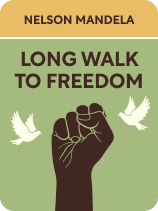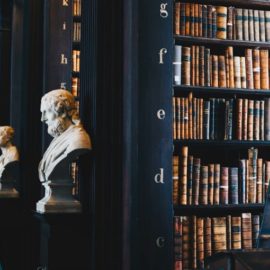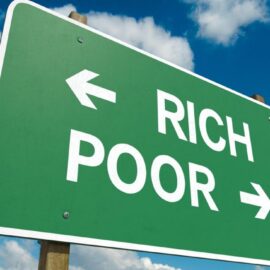

This article is an excerpt from the Shortform book guide to "Long Walk to Freedom" by Nelson Mandela. Shortform has the world's best summaries and analyses of books you should be reading.
Like this article? Sign up for a free trial here.
What was Nelson Mandela’s childhood like? Why, exactly, did he go to prison? What legacy did he leave?
Long Walk to Freedom by Nelson Mandela chronicles his extraordinary life story. Mandela is known as one of history’s great peacemakers, but his own life wasn’t a peaceful one. He had to fight, every step of the way.
Continue reading for an overview of this important book, along with a short exercise to reflect on what you’ve read.
Long Walk to Freedom by Nelson Mandela
Our overview of Long Walk to Freedom by Nelson Mandela explores his experiences during four time periods: his childhood, his time as a young political activist, the years he spent in prison, and the time after his release.
Mandela spent his childhood in troubled, segregationist South Africa. Then, he fought against South Africa’s racist government policies and its system of apartheid from the 1940s to the 1960s, first using nonviolent methods but eventually forming a guerrilla group to fight for racial equality. He then spent 27 years in prison, where he became a worldwide symbol of the South African struggle for freedom. After his release from prison, he was elected President of South Africa, and his legacy is one of reconciliation between Black South Africans and their white former oppressors.
Long Walk to Freedom explores Mandela’s life chronologically—arguably a logical structure for a memoir. In our over, we’ll begin with some background information about South Africa’s history of racial discrimination and apartheid to provide immediate context around Mandela’s experiences. Then, we’ll explore his experiences during four distinct periods: his childhood, his time as a young political activist, the years he spent in prison, and the time after his release.
Note that Long Walk to Freedom was published in 1994 and ends with Mandela being elected President of South Africa earlier that same year. However, Mandela lived until 2013. So, we’ll briefly describe the end of Mandela’s life and the legacy he left behind.
Background: Segregation and Apartheid
Mandela notes that he lived in a time of brutal segregation and white supremacy in South Africa—first under British rule and then later under the South African government’s apartheid policies. While British rule of South Africa officially ended in 1931, Mandela notes, white supremacy reached its peak in 1948, when the National Party (NP) came to power. The NP was an Afrikaner party—the Afrikaners are predominantly white South Africans descended from Dutch settlers.
The NP ran on and then implemented an overtly racist policy called apartheid (literally “apartness”). Mandela explains that apartheid categorized people living in South Africa as either white, Black, or Coloured (mixed race), with a separate category added later for Indians. Based on those categories, apartheid laws determined where certain racial groups were allowed to live, whom they were allowed to marry, and what jobs they were allowed to hold. Public areas were also segregated.
Apartheid was designed to ensure that Black South Africans would remain subservient to whites and be treated as inferior in every way, forever.
African Nationalism
Mandela emphasizes that his struggle against this culture of oppression and apartheid wasn’t just about securing legal rights for Blacks but also about fostering national and racial pride. In short, Black South Africans had to believe that they deserved to be free and that they had the ability to rule themselves.
Mandela’s Early Life
Mandela explains that he was born in 1918, in a small South African village called Mvezo. He was a member of the Thembu tribe, which is part of the Xhosa nation. His father was the chief of Mvezo and the Thembu tribe. Unfortunately, he died when Mandela was only nine years old.
As a child, Mandela had a reputation as a rabble-rouser. His strong sense of justice—and his willingness to cause trouble in pursuit of justice—would define his life and his greatest accomplishments.
Mandela was the first member of his family to attend school. His mother became a Christian and baptized him into the Methodist church. Although Mandela’s birth name was Rolihlahla, he received his Christian name “Nelson” from his teacher on his first day of school.
Mandela’s Education
Later, Mandela went to live with Chief Jongintaba Dalindyebo in the city of Mqhekezweni, the capital of the Thembu province. As the adopted son of a clan chief living in a relatively large city, Mandela was able to get an excellent education for a Black South African of the time, eventually attending university. However, upon learning that Dalindyebo had arranged an unwanted marriage for him, Mandela left university without finishing his degree and fled to Johannesburg.
In 1942, Mandela finally earned a Bachelor of Arts degree and shortly afterward enrolled as a law student. However, he explains, after devoting his life to politics, he neglected his studies and repeatedly failed his final year of law school. He didn’t officially earn a law degree until 1988—over 40 years later—when he completed his LL.B. (bachelor of laws) degree by correspondence while he was in prison.
Mandela the Freedom Fighter
Mandela notes that his lack of a law degree didn’t stop him from getting heavily involved in both law and politics. In the early 1940s, he met Walter Sisulu, an anti-apartheid activist who soon became a prominent figure in Mandela’s life.
Sisulu arranged a clerk job for Mandela at one of the largest law firms in Johannesburg, where Mandela met another Black clerk named Gaur Radebe. Sisulu and Radebe were both heavily involved with the African National Congress (ANC). The ANC sought to use peaceful methods to garner public support for overturning the laws that held back Black South Africans.
Mandela soon became involved with the ANC. However, Mandela notes, many people at the time had become frustrated with the ANC. That’s why, in 1943, Mandela, Sisulu, and others spearheaded the creation of an ANC Youth League.
The Rise of Apartheid
Mandela explains that racial tensions in South Africa came to a head in 1948 when the National Party (NP) won a general election. The NP’s leader, Daniel Malan, then implemented a sweeping and brutal system of oppression called apartheid.
Mandela finally put his law studies to use in 1952 when he co-founded a firm dedicated to defending poor Black people from the NP’s unjust laws.
Escalating Violence Leads to Mandela’s Arrest
Mandela explains that he initially tried to fight back against discrimination and apartheid using nonviolent methods. Eventually, however, Mandela and other ANC leaders became disillusioned with peaceful, legal tactics; they concluded that Black South Africans would need to fight for their freedom.
The ANC tasked Mandela with creating a guerilla force, legally separate from the ANC itself, to fight against the National Party. In 1961, he founded a fighting force called Umkhonto we Sizwe (MK for short), which translates to ”Spear of the Nation.” The MK relied on guerrilla tactics to disrupt the NP’s operations, most notably by bombing government buildings and power stations.
In response to the ANC’s escalating tactics, government forces aimed to capture and convict party leaders, including Mandela. Mandela was found and arrested in 1962. Mandela contended that he had no obligation to follow the NP’s laws, as he hadn’t been allowed to vote in the election that put the NP in power. He further argued that the government had refused to listen to the ANC, leaving violence as their only recourse.
Mandela was convicted of all charges in 1964 and was sentenced to life in prison. Although his crimes would normally carry the death penalty, the NP was facing strong international resistance: Much of the world supported Mandela and opposed apartheid.
Mandela’s Years in Prison
Mandela spent a total of 27 years in three prisons.
Robben Island Prison: 1964-1982
For the first 18 years, Mandela was held in a brutal facility called Robben Island Prison. Prisoners were almost completely isolated from the outside world. While enduring these harsh conditions, Mandela had to stay alert for attempts on his life.
Mandela notes that, at Robben Island, the prisoners engaged in numerous protests against the prison’s inhumane conditions and practices. Most commonly, they went on hunger strikes. Mandela says that he advocated for more disruptive forms of protest, such as refusing to work or refusing to clean. However, he was often outvoted.
Pollsmoor Prison: 1982-1988
In 1982, the authorities moved Mandela to Pollsmoor Maximum Security Prison, located near Cape Town. Mandela says that, compared to his previous situation, Pollsmoor seemed luxurious.
In 1985, prison authorities moved Mandela to a solitary room. Though he regretted being separated from his compatriots, Mandela took advantage of his isolation to start writing letters to the government, trying to arrange a meeting between the ANC and the NP.
Mandela notes that, even while he was in prison, his name and message continued to spread. Resistance—much of it violent—built against the National Party as more and more South Africans joined Mandela’s cause.
That’s why, in 1985, State President P. W. Botha offered to release Mandela from prison if he publicly denounced the ongoing violence against the government. Mandela refused.
Victor Verster Prison: 1988-1990
Mandela recalls that, in 1988, he contracted tuberculosis. Once he’d recovered, instead of returning to Pollsmoor, he was moved to Victor Verster Prison. Mandela says that Victor Verster Prison had an excellent reputation and was much more comfortable than even Pollsmoor.
Mandela continued his efforts to arrange a meeting between ANC and NP leaders. In July of 1989, his efforts paid off and he had a brief meeting with State President Botha. It was the first time that party leaders had come together for peaceful talks.
Mandela’s Freedom and Presidency
In 1989, F. W. de Klerk became state president. At his order, Nelson Mandela was finally released from Victor Verster Prison on February 11, 1990.
Mandela and de Klerk Tear Down Apartheid
According to Mandela, de Klerk’s administration began the daunting project of dismantling apartheid. De Klerk met with Mandela in December of 1990 to discuss how South Africa could move forward as a unified nation.
Mandela recalls that two of the largest problems that he and de Klerk had to overcome were Black South Africans’ desire for revenge against their oppressors and white South Africans’ fears that they themselves would be oppressed under a majority Black rule. The ANC’s mission statement—to be a party for all South Africans, regardless of skin color—was instrumental to the reconciliation process.
Negotiations between the ANC and the National Party went on for years as party leaders hashed out how to dismantle the infrastructure of apartheid in a way that benefited everyone. Mandela and de Klerk jointly received the 1993 Nobel Peace Prize for their work in overturning apartheid and bringing democracy to South Africa.
President Nelson Mandela
Mandela explains that he was elected president of the ANC in 1991. After he and de Klerk worked together to eliminate apartheid’s race-based voting restrictions, Mandela went on to win South Africa’s first democratic general election in 1994.
Once Mandela was installed as president, he appointed de Klerk as his second deputy president. This meant that de Klerk was Mandela’s assistant and third-in-command of the government—behind the first deputy president (Thabo Mbeki) and Mandela himself.
This wasn’t the first general election held in South Africa, but it was the first time that citizens of all races could vote: Therefore, it was the country’s first truly democratic election. Furthermore, the constitution that de Klerk’s administration drafted officially created an Office of the President—previous leaders had held the title of Prime Minister or State President—which is how Mandela became the first President of South Africa.
| Mandela’s Legacy and South Africa Today Nelson Mandela passed away on December 5th, 2013, at the age of 95. Around 4,500 people attended his funeral, ranging from family members and former political prisoners to world leaders. Millions more watched the ceremony on TV. Mandela is most often remembered not as a freedom fighter, nor as a politician, but as a peacemaker. His legacy is beginning the reconciliation between Black South Africans and the Afrikaners who oppressed them, helping to build the first fully democratic South African government. Though apartheid and legalized discrimination were repealed decades ago, South Africa’s people are still grappling with the aftermath of those devastating policies. Even today, Black South Africans are far more likely to live in poverty than their white counterparts and have much lower economic mobility. Furthermore, while racial discrimination is now illegal, the South African government continues to use racial classifications for its citizens. This is theoretically to keep track of economic recovery and to correct the imbalances left behind by apartheid through affirmative action programs. However, some people argue that those categories are only worsening racial divisions and say that the government should be offering assistance based on economic status rather than race. In short, while Nelson Mandela made enormous strides toward creating a fair and democratic South Africa, there is still a long way to go before the country is truly racially equal. |
Exercise: Reflect on Long Walk to Freedom
Now that you’ve read about some of the highlights of Nelson Mandela’s life, take some time to reflect on what you’ve learned about him and the apartheid system he helped to dismantle.
- How familiar were you with Mandela and the apartheid system before reading this guide? Note down your prior knowledge and opinions of them.
- What was the most surprising thing you learned about Mandela and apartheid from reading this guide?
- What was the most interesting or inspirational thing about Mandela that you learned?

———End of Preview———
Like what you just read? Read the rest of the world's best book summary and analysis of Nelson Mandela's "Long Walk to Freedom" at Shortform.
Here's what you'll find in our full Long Walk to Freedom summary:
- Nelson Mandela’s extraordinary life story, as told by the man himself
- Why it took Mandela over 40 years to finish his law degree
- Nelson Mandela’s legacy and what South Africa is like in its post-apartheid years






